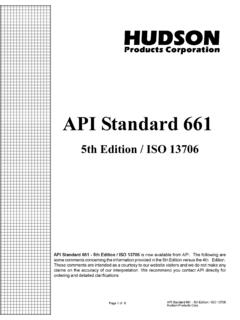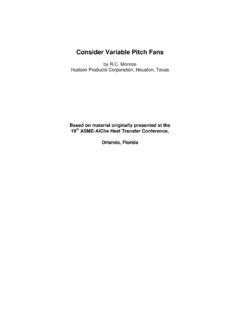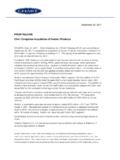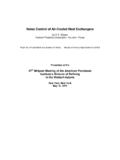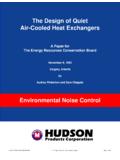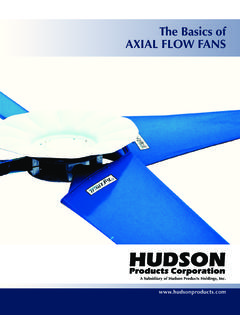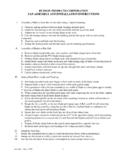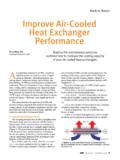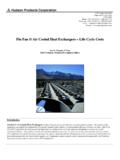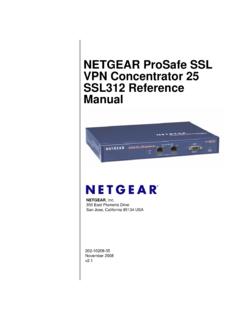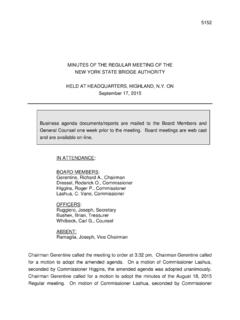Transcription of Summary Tuf-Lite III vs. Tuf-Lite II
1 Summary Tuf-Lite III. vs. Tuf-Lite II. hudson Products Corporation - Sugarland Tx Beasley Tx hudson PRODUCTS CORP. 1 of 5 9/8/2004. Tuf-Lite III Introduction & Background This document is intended to present the history, the design basis, and the manufacturing process for the Tuf-Lite III (K-blade) product. History - Original Blade Business & Tuf-Lite B Blade: hudson Products first entered the axial flow fan market in 1957 when hudson supplied fan hubs to the cooling tower market. Around 1958-1960, hudson Products introduced the T-blade which was followed by the E-Series blade in the early 1960's. The B-blade, starting up in about 1967, evolved into a blade design that covered the smaller sizes to go with our air-cooled heat exchangers all the way up to the largest power plant cooling towers. Being a product of their times, these early blades were all manual - lay-up, resin addition, and molding - using the best glass available at the time. History - Tuf-Lite II H Blade: hudson Products recognized in the 1980's the need to develop a new design which took advantage of the latest automated molding processes and the most optimum glass materials available.
2 A two-piece design was required in order to remove the re-useable preforms from each piece. Current Tuf-Lite III K Blade: The 1990's represented a period of increased competition where reliability and performance were both carefully correlated to investment, operating, and maintenance dollars. hudson Products developed the new Tuf-Lite III design, which combines the strength and reliability of a single-piece blade design, improved aerodynamic performance, and the production economies of the latest molding processes and FRP materials. The new K blade is shown below an H blade in the following picture: Tuf-Lite II H-blade . ( hudson Blue). Tuf-Lite III K-blade . ( hudson Teal Green). Sizes, Applications, & Production: Tuf-Lite III is currently produced in fan diameter ranges of 22 33 ft, which covers the cooling tower market in power plant, geo-thermal, general industrial, and petro-chemical industries. Production currently involves a closed mold process controlled by a micro-processor. hudson PRODUCTS CORP.
3 2 of 5 9/8/2004. K-blade or Tuf-Lite III Design Basis Conceptual Design: Design Advantages: The main advantages of Tuf-Lite III over Tuf-Lite II are, largely attributable to the single-piece construction in all areas: Aerodynamic performance is enhanced by a blade shape, which better fits the seal disc assembly. The more robust structure of Tuf-Lite III, proven in FEA analysis, static destructive testing, long term endurance tests, and field run installations has allowed hudson to increase the horsepower per blade loadings much beyond those levels heretofore allowed in either Tuf-Lite and Tuf-Lite II. Seal Discs: Seal discs have been re-designed for Tuf-Lite III with changes in the shoulder of the blade. The shoulder chord of the new blade is wider and nestled within the envelope of the seal disc so that the new seal disc has a deeper dish to it. The reinforcing rib height and average thickness of the K-blade seal discs have been increased for long-term reliability. Hub-Spool & Blade-Clamp Assemblies: The design format of the new blade is based on sharing the classic and robust double plate and split-clamp 5000 and 6000 Series hub assemblies with the H-blade.
4 These hub and clamp designs have been proven to be reliable and cost-effective workhorses for the bulk of hudson applications for both cooling towers and air-cooled heat exchangers. Depending on the installation environment, there is a choice of clamp materials, surface coatings, and fastener material/grade. Other Retained Features: The benefits of a molded FRP blade allow a tapered and twisted blade such that greater twist (aerodynamic angle of attack) and wider chord width exist progressively near the root of the blade. This compensates for the progressively slower blade velocity and otherwise lower aerodynamic lift near the blade root. The patented Tuf-Edge leading edge erosion feature developed in Tuf-Lite II continues to be incorporated in Tuf-Lite III blades. Tuf-Lite III Aerodynamic Performance Certified Laboratory Performance Test Program: In order to determine Tuf-Lite III performance, as done earlier with with Tuf-Lite and Tuf-Lite II, the full- size fan has been scaled-down in size on a 6:1 ratio and tested at scale model flow rates in the Texas A&M.
5 ESL Laboratory wind tunnel. In this test, total fan pressures and shaft powers is obtained over a range of airflow values between shut-off and free-air . Each fan data point is then corrected for a standard speed and air density. The ESL procedures are in compliance with AMCA 210 fan industry test procedures. Tuf-Lite III Strength and Endurance Finite Element Analysis Modeling: A finite analysis model (Pro/E and ANSYS) has been constructed and analyzed for the Tuf-Lite III new product. The concentration of higher stresses in the neck, transition, and shoulder areas of the blade has been minimized by strategic placement of the appropriate number and type of glass in those critical areas. Product Development Testing: During the development process, a certain number of prototype blades have been subjected to a series of engineering and quality control inspections of both non-destructive and destructive nature. All K-blade sizes have been tested for static loading ( buckle ), mechanical natural frequency, weight consistency, moment-balance trends, FRP lay-up compliance, and thickness variation.
6 hudson PRODUCTS CORP. 3 of 5 9/8/2004. Blade Fatigue Testing: In the course of 3-1/2 years, eight (8) thirty-foot K-blades have been tested in two different long term dynamic exterior tests at the Beasley Long Term Blade Endurance Test (LTBET) facility. This is a facility where blades are passed over two unloading baffles causing alternate compressive and tensile stresses in the blades. The following tables summarize the nature and results of the last test. Two 30K and two 30H. blades were tested in a 4 blade fan configuration such that all blades saw the same rigors of endurance testing. Note that this is an intense, accelerated test program which blades do not normally see in the field: 30K/H-4 LTBET Test Summary Test Dates 8/20/02 7/4/04. Total Duration 5,178 hrs * Ahp/Blade 40-43. RPM 138 Tip Speed 13,006 fpm Blade Pitch 21 deg Baffles 2 @ 13 . Results: (9) 30H blades replaced; No 30K blade failures, No Hub or clamp failures, No Seal-Disc Failure *Total No. Of Stress Reversal Cycles = x 10^8.
7 Field Run Testing: hudson has installed 28 foot and 30 foot K-Blades at selected customer sites in cooling tower applications in order to confirm both performance and reliability. Refer to the following table summarizing current Tuf- Lite III field run experiences. Summary : Field Run Tests As of Date 9/7/2004. Install Date Application Equipment No. of Days No. of Hrs 5/10/2001 Round, Multi-Cell (2) APT-28K-8 1197 28728. Cooling Tower 11/15/2001 Cooling Tower (1) APT-28K-8 1012 24288. 2/6/2002 Cooling Tower (1) APT-28K-8 931 22344. 5/13/2002 Cooling Tower (1) APT-30K-8 834 20016. Field Performance Testing: Field tests of full size units has been performed in order to confirm scale model tests in the laboratory and scale-up procedures. These tests have been performed by our Field Service team according to procedures specified by AMCA-210, API-661, and CTI with the emphasis on larger cooling towers. Such test results usually support the conventional theory that the fan laws are conservative particularly for the larger sizes - for both air delivery and power consumed.
8 hudson PRODUCTS CORP. 4 of 5 9/8/2004. Tuf-Lite III Manufacturing Process and Quality Assurance K-blade FRP Lay-up: The basic lay-up in the Tuf-Lite III new product shares many of the characteristics of a previously successful product, Tuf-Lite II. Certain glass has been re-arranged in orientation and ply quantity to concentrate the strength in the high stress areas and /or to eliminate known strength bottlenecks in the earlier design. The high stress areas are in the blade neck, blade neck-to-shoulder transition, and blade shoulder areas. One glass component has been replaced in type so as to increase strength in these critical areas accordingly. K-blade FRP Molds: The basic mold design has borrowed upon the successful H-blade line but certain improvements have been incorporated in the new equipment fabricated under the Tuf-Lite III project. New mold features improve neck geometry and quality as well as lowering both blade rejects. Quality Assurance: The above development data has resulted in the generation of manufacturing standards for production of the K-blade.
9 The Q-C program also includes monitoring the vacuum mold process for consistency of parameters such as times, temperatures, and pressures as recorded on circular chart recorders. To ensure consistency of product strength, reliability, and performance, all hudson blades are periodically sampled, dissected, and measured for FRP lay-up and mold standards. Section thickness is measured, recorded, and monitored for dimensional stability. This type testing augments moment balancing, weighing, vibration, finish, and buckle testing in guaranteeing consistent and on-going quality standards. In addition to formalized standard procedures for Q-A, as it is noted for, hudson Products has periodic, quality-oriented, Continuous Improvement meetings comprised of interested parties from all the functional areas related to the product. hudson PRODUCTS CORP. 5 of 5 9/8/2004.
